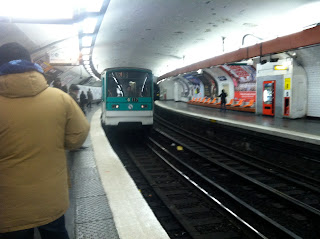 |
| The sign we associate with locomotion en francais |
Yes, that aging steel and concrete subterranean behemoth has become a serious object of my affection. Its efficiency, its simplicity, its ubiquity mark it high on my list of good things to have in my life every day.
The Paris Metro is the way to get around in this city. The city of Paris - the world-renown city of monumental splendor and the Eiffel Tower, the Louvre, les Invalides, the Quartier Latin and Notre Dame - is a compact ball of urbanity with high population densities everywhere and a physical structure that allows for quick movement from point to point.
One of the paradoxes of Paris is that such a consistently magnificent jewel of a city was created with the very deliberate notion that people should be living cheek by jowl, one person literally on top of the other. The concept that a successful city should accommodate people's innate desire to accumulate and spread out does not appear to ever have been an issue in Paris. But unlike American cities of high densities, Paris has created this density not by spiking up tall towers, but through a consistent building height everywhere. It is an amazing statement of the control that planners and urban designers have had over this place to see that line of rooftops vanishing into the distance.
 |
| Paris by rooftop, from Montmartre |
The very dense agglomeration of housing is pierced by boulevards (courtesy of Haussmann) for surface transit, and is wrapped underneath by a network of underground tubes that is the Paris Metro.
 |
| Tubes, tubes everywhere, both with and without rails |
The efficiency of the Metro is something to experience for an American pair of eyes. The arrival of a train every 2-3 minutes is miraculous to the someone accustomed to the random dice roll of taking the T in Boston, when train spacing may leave you lonely and trainless on a station platform for over 10 minutes on the bad days.
 |
| Ah, here's my train now |
Of course, Paris couldn't really function without it. The system, if not running at capacity, is running pretty darn close. Regardless of day or time of day, the train cars are full. And at rush hour times, they are more than full, they are crammed.
 |
| Le Metro crowd, at any hour on any day |
The expansion of this system is the next step. The ancient city of our imagination is really only a small part of the larger urban region, and houses only 2 million of the larger region's almost 10 million people.
The proposal is to extend a loop out 20 miles from the city center, to take into account the suburbs that are now serviced by an incomplete spoke-structure RER regional train service. It does pose the very serious question of what happens when all these additional riders have access to the inner-city Metro, since they can add neither more cars nor increase the frequency of trains. Nevertheless, I think of all the delays in the Green Line expansion in Boston, and I have an inner bet with myself that the French will get this done well and much sooner.
In our evolving green consciousness, a public transit system that works with high frequency and incredibly high usage should cause us envy at the very least. For me, it is love.
 |
| With a lion there to watch over it, at Place de la Concorde |
On a somewhat humorous note: the new 20-mile loop system is designed to be a fully automated system, with no train driver. One reason for this is to try to avoid the frequent driver strikes that paralyze the transit system and the city on a regular basis. On this one, I suspect it will be Drivers Union 1, Computers 0.